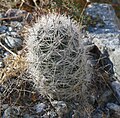Cochemiea tetrancistra
| Cochemiea tetrancistra | |
|---|---|
 | |
Conservation status | |
 Least Concern (IUCN 3.1)[1] | |
| Scientific classification | |
| Kingdom: | Plantae |
| Clade: | Tracheophytes |
| Clade: | Angiosperms |
| Clade: | Eudicots |
| Order: | Caryophyllales |
| Family: | Cactaceae |
| Subfamily: | Cactoideae |
| Genus: | Cochemiea |
| Species: | C. tetrancistra |
| Binomial name | |
| Cochemiea tetrancistra (Engelm.) P.B.Breslin & Majure | |
| Synonyms | |
| |
Cochemiea tetrancistra is a species of fishhook cactus known by the common name common fishhook cactus. It is native to the Mojave and Sonoran Deserts of northern Mexico and the southwestern United States, where it grows in a variety of desert habitat types.
Description
This cactus generally has a single cylindrical stem a few cm wide and up to about 25 cm (9.8 in) tall and 3 to 8 cm (1.2 to 3.1 in) in diameter with tuberous roots. The cylindrical warts do not produce milky juice, and the axillae are covered with bristles.Each cluster of spines is made up of 3 or 4 dark, hooked central spines and many straight, white radial spines, the longest reaching 2.5 cm (0.98 in) in length. The 30 to 60 radial spines are hair-like, arranged in two rows, white with dark tips, and 6 to 10 mm (0.24 to 0.39 in) long. The flower is 2 to 4 cm (0.79 to 1.57 in) wide and pink to lavender in color. The fruit is red, shiny, 1.2 cm (0.47 in) long and fleshy and contains many black seeds coated in corky arils.[2]
-
 Flower of Cochemiea tetrancistra
Flower of Cochemiea tetrancistra -
 Fruit
Fruit -
 Plant
Plant
Distribution
Cochemiea tetrancistra is found in California, Arizona, Nevada, Utah, and the Mexican states of Baja California and Sonora at elevations of 100 to 1500 meters.[3]
Taxonomy
Originally described as Mammillaria tetrancistra by George Engelmann in 1852, the name tetrancistra comes from Greek words for 'four' and 'hook,' referring to the hooked central spines.[4] In 2021, Peter B. Breslin and Lucas C. Majure reclassified it into the genus Cochemiea.[5]
-
 Plants growing in habitat southern section of the Mojave National Preserve
Plants growing in habitat southern section of the Mojave National Preserve - Plant growing in Joshua Tree National Park
References
- ^ "The IUCN Red List of Threatened Species". IUCN Red List of Threatened Species. 2010-05-12. Retrieved 2024-06-02.
- ^ Anderson, Edward F. (2011). Das große Kakteen-Lexikon (in German). Stuttgart (Hohenheim): Ulmer. p. 412. ISBN 978-3-8001-5964-2.
- ^ "Mammillaria tetrancistra". FNA. 2020-11-05. Retrieved 2024-06-27.
- ^ Silliman, Benjamin (1852). "The American journal of science and arts". S. Converse. ISSN 0099-5363. Retrieved 2024-06-27.
- ^ Breslin, Peter B.; Wojciechowski, Martin F.; Majure, Lucas C. (2021). "Molecular phylogeny of the Mammilloid clade (Cactaceae) resolves the monophyly of Mammillaria". Taxon. 70 (2): 308–323. doi:10.1002/tax.12451. ISSN 0040-0262.
External links
 Media related to Cochemiea tetrancistra at Wikimedia Commons
Media related to Cochemiea tetrancistra at Wikimedia Commons Data related to Cochemiea tetrancistra at Wikispecies
Data related to Cochemiea tetrancistra at Wikispecies- Jepson Manual Treatment — Mammillaria tetrancistra
- USDA Plants Profile for Mammillaria tetrancistra
- Flora of North America
- Mammillarias.net Profile
- Cochemiea tetrancistra — UC Photo gallery



















